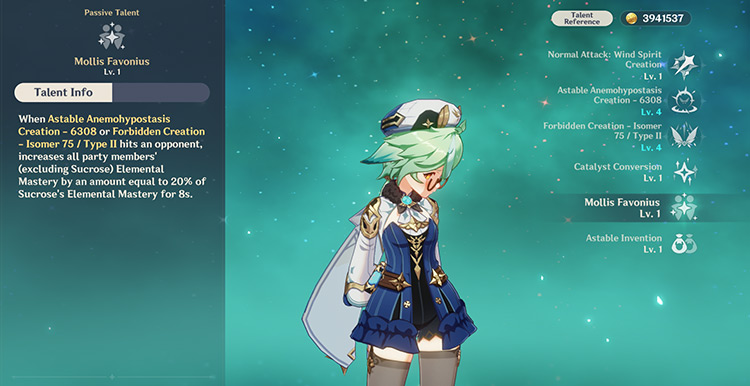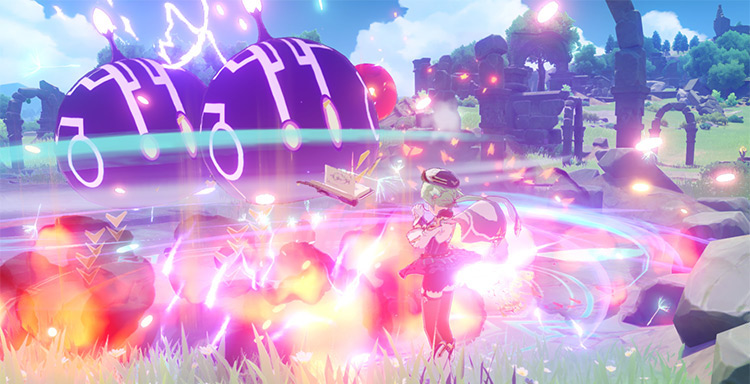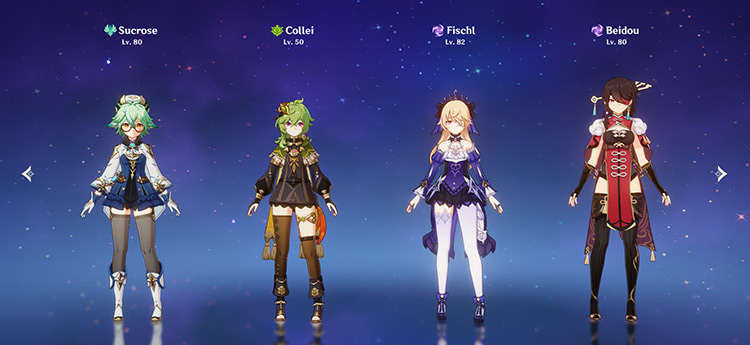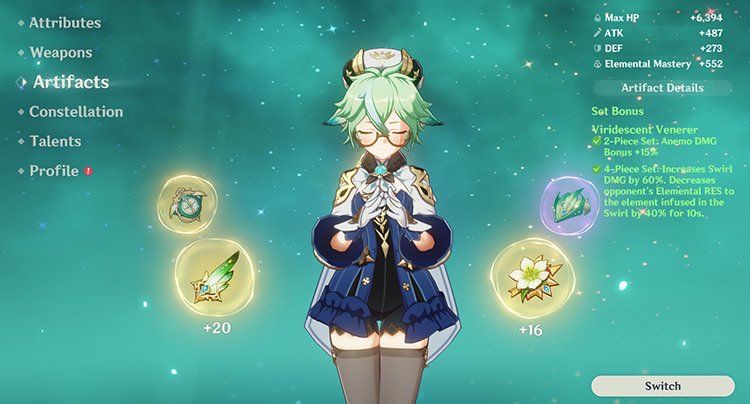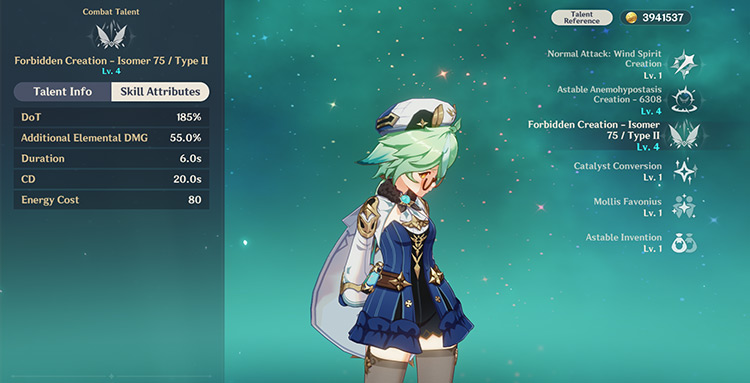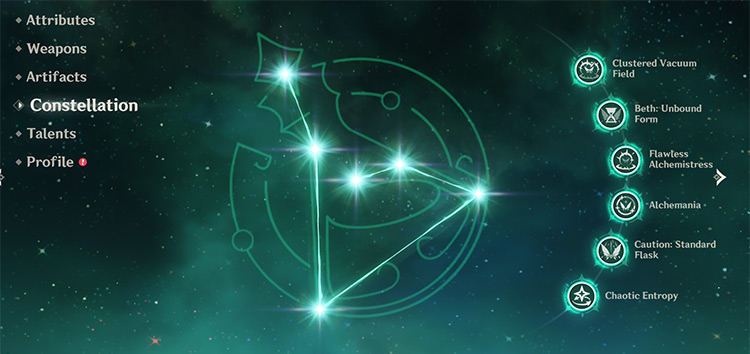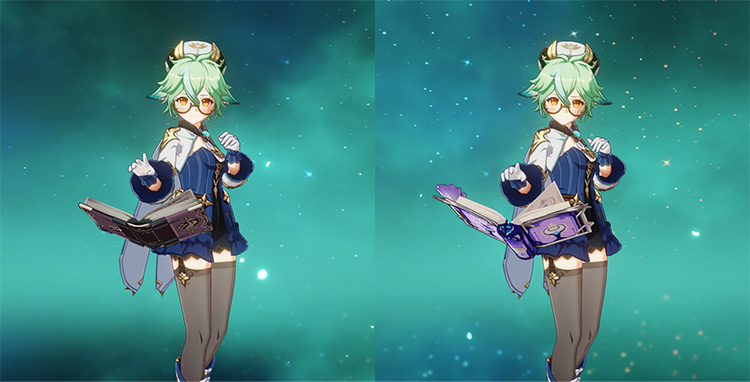These basically let her fit into plenty of teams, even in ones that don’t benefit from EM. Plus she can easily fill a variety of roles, be it off-field or on-field. So Sucrose has a lot of versatility for team building. She’s also relatively easier to build – just stacking EM and equipping 4pc. Viridescent Venerer is enough to make her work. You’ll basically never go wrong with building and using her.
Pros & Cons
Sucrose Strengths
Sucrose is single-handedly the only unit that shares an abundance of Elemental Mastery (EM) with the entire team. This makes her an overall great unit for teams that trigger plenty of elemental reactions. Sucrose also offers a lot of other utilities aside from EM share. The most notable ones are elemental resistance shred, energy generation, crowd control, and sometimes ATK buffing when using the Thrilling Tales of Dragon Slayers (TTDS) weapon.
As a catalyst user, she can easily trigger swirl reactions and 4pc. Viridescent Venerer set’s passive. This guarantees very high uptime on elemental resistance shred. She generates a lot of Anemo energy particles, thus making her a powerful Anemo battery — most notably for Xiao. Both her skill and burst can crowd-control opponents. This is especially useful against AOE or plenty of enemies. Sucrose can also equip the TTDS book which gives a 48% ATK buff to teammates.
These basically make her an even better candidate for a lot of teams. Sucrose can easily slot into most teams thanks to her plenty of utility. Even in teams that can’t fully use her kit, she’s still a good option. For instance, Xiao doesn’t benefit from her EM share, but Sucrose is still amazing with him. This is thanks to her strong energy generation, crowd control, and ATK buffing. Additionally, her flexibility lets her fill multiple roles — most notably as a support and DPS, both off-field and on-field. For instance, in a Sukokomon team (Sucrose-Fischl-Xiangling-Kokomi), she works as both an on-field support and DPS. Her EM share buffs her teammates, while she deals a lot of on-field damage herself. And in teams like International (Sucrose-Bennett-Xiangling-Tartaglia), she acts as an off-field support. Sucrose doesn’t contribute a lot of personal damage or stay on-field, but she’s still buffing the entire team. There are also multiple other teams where she fulfills a mix of these roles. Sucrose is very easy to build, and she works even with low investment. But it’s still better to build and level her more because she scales really well with investments. Her only build requirements are:
Full Elemental Mastery with a 4pc. Viridescent Venerer artifact set Thrilling Tales of Dragon Slayers or Sacrificial Fragments weapon Leveled character levels — level 90 is definitely worth investing in
There’s absolutely no need to level character talents or optimize her CRIT ratio.
Sucrose Weaknesses
Sucrose has an expensive burst cost of 80 energy. Although she already generates a lot of energy particles, it’s still recommended to build Energy Recharge for her burst. This is especially true when she’s the only Anemo unit in the team, if she’s mostly off-field, or when you need her burst every rotation.
Are Sucrose’s Constellations Good?
Sucrose has a mix of great and bad constellations. If you’re planning to pull for them, C1 is the best one to go for – plus it’s also her earliest constellation. This basically adds one more charge to her skill, which is an overall amazing upgrade to have. Her next good constellation is C6, but it’s not recommended to actively pull for this one. It’s much more difficult and expensive to obtain. Instead, you’ll naturally get her constellations anyway – so you’re bound to get C6 Sucrose. Let’s take a closer look at each one.
C1: Clustered Vacuum Field
Sucrose’s skill gains 1 additional charge. This is her best constellation. It gives her an additional skill cast — aka additional EM share uptime, crowd control, damage, energy generation, and chance to proc Sacrificial Fragment’s passive. It’s highly recommended to get this constellation.
C2: Beth: Unbound Form
Increases her burst duration by 2s. It’s a nice constellation that also increases every utility that her burst offers, such as crowd control.
C3: Flawless Alchemistress
Increases her elemental skill talent level by 3. This is a direct damage increase but not a big one. This is because Sucrose mainly deals damage through swirl reactions that only scale off EM and character level, not talent level.
C4: Alchemania
Every 7 normal or charged attacks Sucrose hits against opponents will reduce her skill cooldown. One hit may be counted every 0.1s. This is her second best constellation when she’s the on-field unit. It basically reduces her skill cooldown by 1-7s, thus letting you cast it more often. C4 is basically a slightly conditional version of her C1.
C5: Caution: Standard Flask
Increases her elemental burst talent level by 3. This is exactly the same as C3. It’s a damage increase but not a lot.
C6: Chaotic Entropy
If her burst absorbs an element, all party members gain a 20% elemental damage bonus of the element absorbed. This lasts for the burst’s entire duration. It’s generally hard to control the elemental absorption of Sucrose’s burst. So the value of C6 depends on how consistently you can choose and get its buffs. Otherwise, it’s pretty irrelevant. You only occasionally get the damage bonus.
Thrilling Tales of Dragon Slayers vs. Sacrificial Fragments for Sucrose
Thrilling Tales of Dragon Slayers (TTDS) and Sacrificial Fragments are very competitive options for Sucrose. Still, one can situationally be better than the other. Here’s a more detailed list of scenarios when one outperforms the other. Both weapons actually work well in every scenario. There’s simply a slightly better option depending on the team comp.
